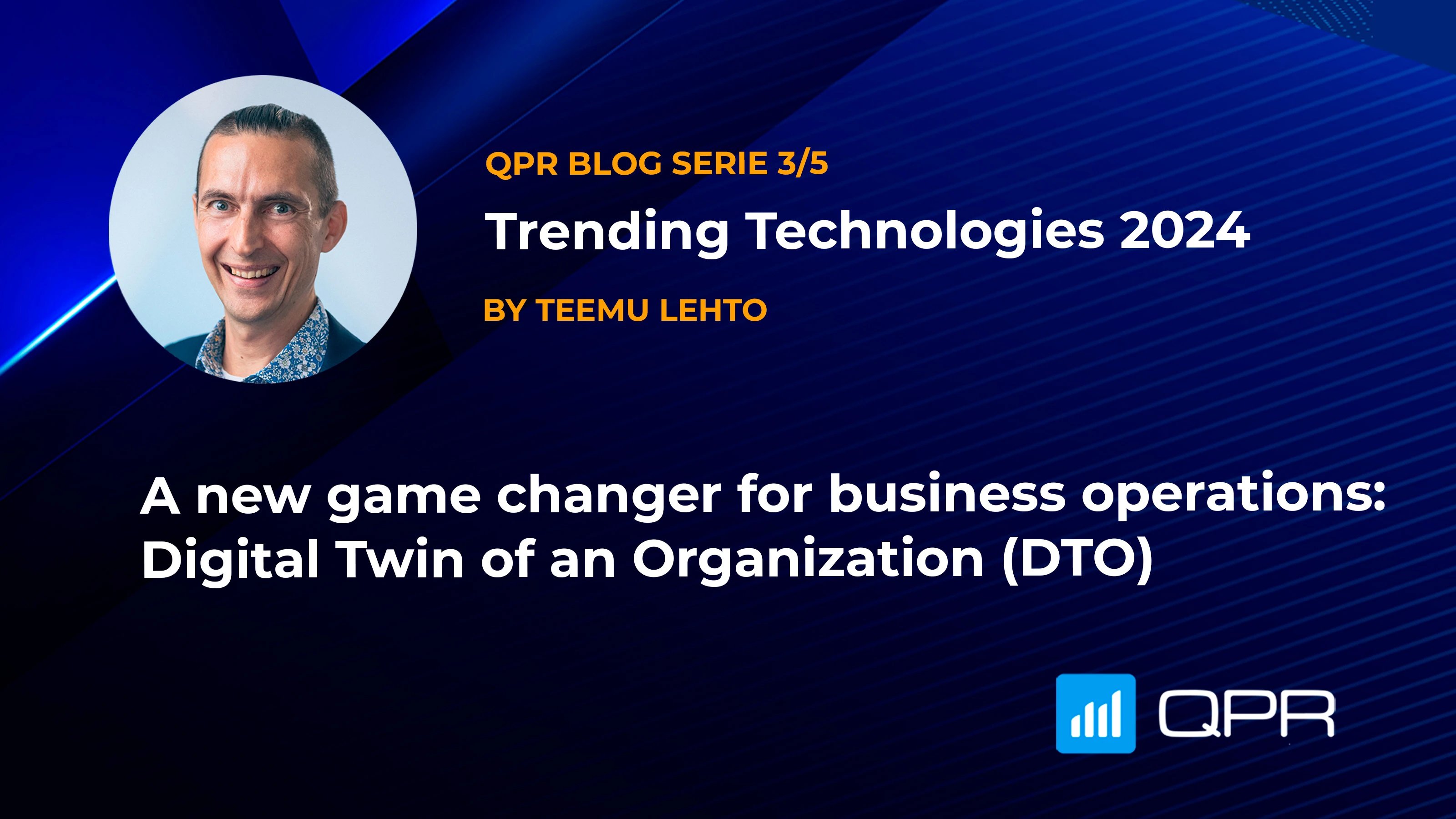Process mining for digital transformation
Although "digital transformation" has possibly been mentioned in every corporate playbook, many organizations have failed to achieve the desired outcomes with their initiatives. And while the recipe for digital transformation success rightfully varies in each business, there remains one common ingredient: timely and accurate insights into organizational operations.
This blog post will discuss what I believe to be the ultimate companion in your digital transformation journey: intelligent process mining.
New to the process mining concept?
Read the "Whats, Whys, and Hows of process mining" on our pillar page.
Check out our "What is process mining?" blog post.
What is digital transformation?
Or more precisely, what is the digital transformation concept that I will discuss in this blog post? The term can be used to describe almost every business transformation project that attempts to integrate digitization in various areas of your organization, from business model, to operational processes, to organization culture. This blog post will focus on the initiatives to embrace digitization in your end-to-end business processes, change the entire way your organization operates and deliver value to your customers.
If you're already familiar with the process mining basics, continue reading as I'll discuss the most common digital transformation challenges in large organizations, then critical areas where process mining can help improve, namely, value stream mapping, agile organization, and business transparency. Lastly, I'll present you with some exemplary next steps on how you can start using process mining to kick-start your digital transformation journey.
See the on-demand webinar in this topic and download the presentation slides here.
Writer's notes: This blog post was originally published in May 2020, and has been updated in 2022 for accuracy and comprehensiveness.
1. Digital transformation challenges
From our experience of over 30 years in business process management, the most common challenges for organizations in their digital transformation journeys include the speed of technological change, new business models, complexity in management, end-to-end process automation, and the need for data-driven analysis.
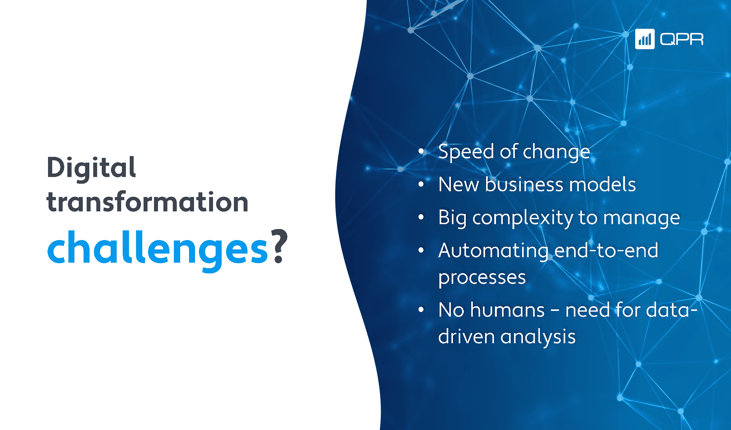
Speed of change
As technology is changing by the minute, companies also need to keep themselves updated and proactive accordingly! Amid this corona crisis, we've seen that everything is changing suddenly and rapidly worldwide and that the business plan you prepared last year might no longer be relevant today.
From the technology viewpoint, changes keep coming faster than ever. Organizations need to have a solution to guide themselves through these new circumstances, and process mining is the optimal choice.
Take the camera industry for example: film cameras were beloved by the average consumers 20 years ago then swiftly replaced by digital cameras in every household. For the past ten years, phone cameras keep getting better and better, even ambitiously trying to take digital cameras out of business. At the same time, digital cameras kept evolving and gave birth to mirrorless ones, while film cameras recently have made their way back to the competition, proving that the most unexpected things can and will always happen in the business world.
New business models
In the span of 10-20 years, we've witnessed how many new business models have effortlessly replaced old ones. Before, people went to the stores to shop for groceries, clothing, or electric devices. Nowadays, almost everything can happen digitally: online shopping, remote working, and so on. The advancement of technology plays a massive part in this change. If you can purchase everything from your sofas and have home deliveries, why bother going to the stores anymore?
In B2B organizations, the changes are also happening (though slowly), thanks to the shift in behaviors and mindsets in the B2C setting.
Complex processes and the ambition to automate them
As many organizations prioritize cutting costs in this troubled time, business owners urgently look for ways to simplify their operational processes. What can save more time, effort and resources than one-size-fits-all processes?
However, the more businesses are trying to simplify their processes, the more customers prefer customized products and services, especially in the B2B world. This poses a dilemma for business leaders in their digital transformation journey: making the processes simple but keeping the customers happy.
Process mining is the tool that can give you 100% coverage of your end-to-end processes and guide your next digital transformation activities, i.e. how and where to apply RPA. (Learn more in our blog post process mining for RPA.)
No humans - need for data-driven analysis
Back in the days when there was not as much automation in the process, the insights and evaluations of a process came from the experts and the workers. The more you automate your business processes, the less human involvement happens. Eventually, you'll be able to achieve zero-touch operations, but how do you know if everything is going well?
The answer to this challenge is, again, process mining. Even when your circumstances allow you to conduct interviews and group discussions to review how well a process goes, we at QPR would still advise you to use process mining for KPI reporting, monitoring, and auditing purposes. In our experience, it's almost impossible to gather unbiased opinions from workers, whereas process mining provides you with fact-based insights based on data from your own information systems.
2. Value stream mapping
The concept of value stream mapping is that you should understand what activities can add value to your customers, and avoid the unnecessary and costly steps in your processes.
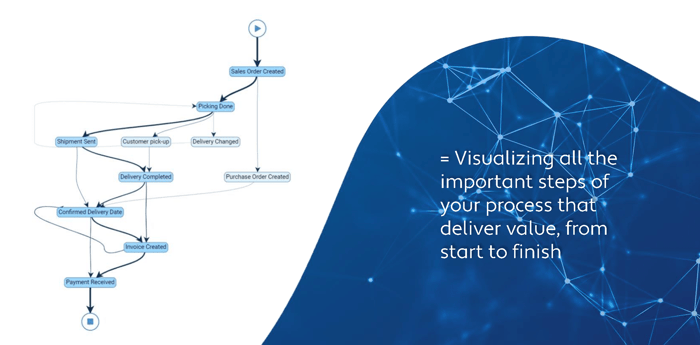
3. Agile organization
With the reasons mentioned above, it's crucially to make your organization agile by understanding the changes around you and react rapidly to them. Moreover, you should continue monitoring and keeping things in check so that you can achieve the ultimate goal of creating an agile culture in your own organization.
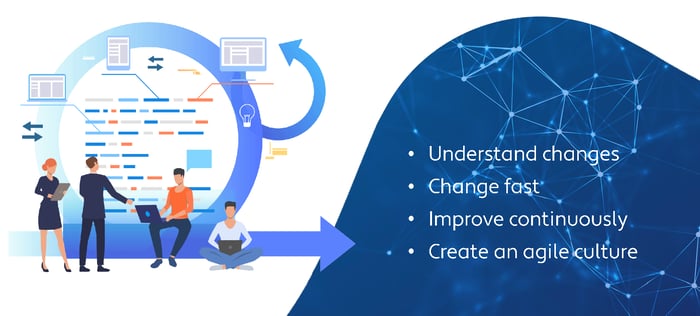
4. Business transparency
Last but not least, process mining helps you to achieve business transparency, which is a long-term, comprehensive goal in your digital transformation journey.
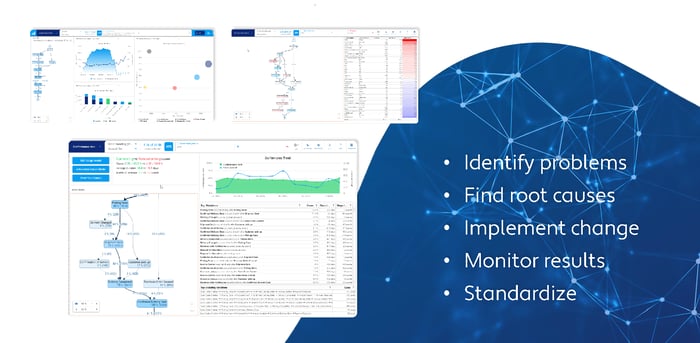
5. Process mining benefits in digital transformation
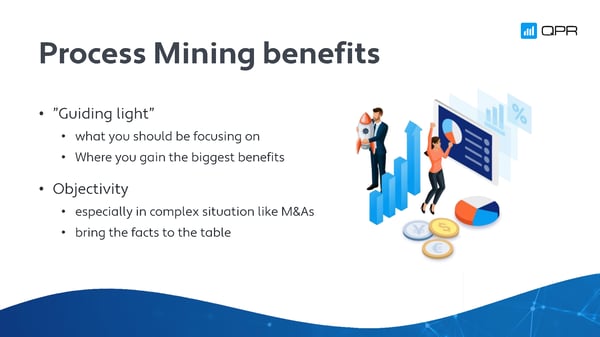
It’s a good time to take a look at Process Mining if your company hasn’t already. The capabilities and usability of Process Mining software are improving rapidly, and the market is quickly becoming mature, although there’s still much work to be done.
If you think your company is ready to step it up with the future of as-is process modeling and process efficiency maximization, the fastest way to get things moving is to follow these steps:
You may also like
These related stories

Best practices for deploying process mining in large organizations

Process mining for auditing and compliance
